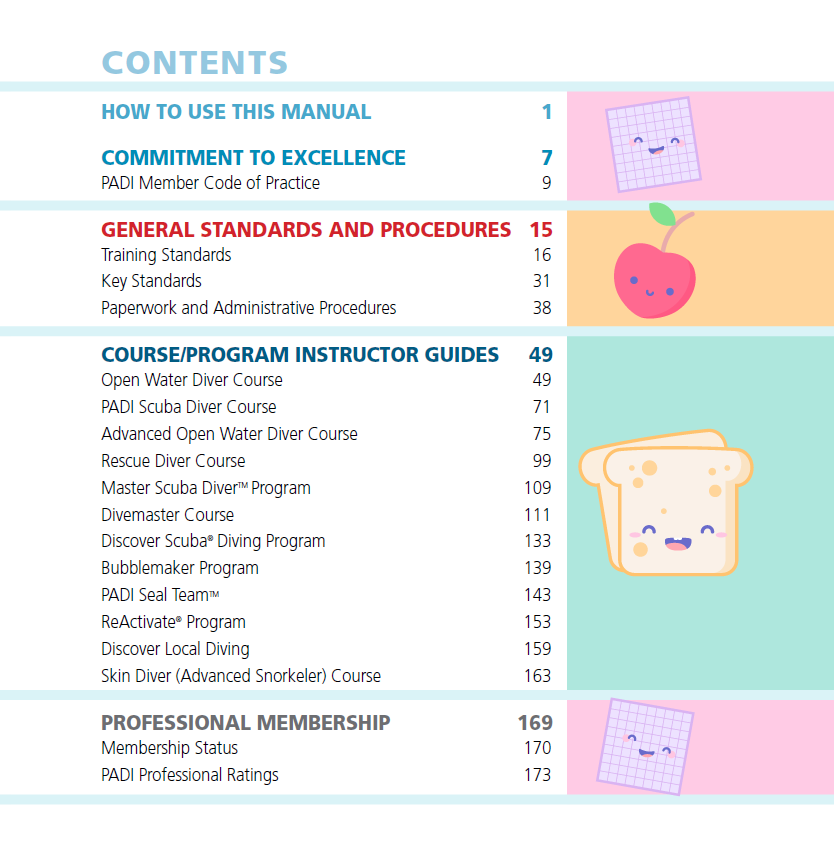THE DIVE PRO HUB
blog series

HOW TO USE THE PADI INSTRUCTOR MANUAL
5 TOP TIPS TO MAKE LIFE EASY
During my career, I've spent a lot of time with one little PDF in particular. If it's not already your best friend, it's time to get acquainted! Knowing how to use the PADI Instructor Manual is key to your success as a dive pro.
In this article, I'm going to give you 5 top tips I've picked up over the years.
Let's take a look...

HOW TO USE THE INSTRUCTOR MANUAL | TIP 1
Remember, you don't need to memorise the whole thing. Unless you've got a photographic memory like my mate Edd who can literally recall every standard from every course of every training agency under the sun, you're setting yourself up for a hard time.
Most normal people can't memorise a 200 odd page document. And actually, it's often not the smartest thing to try. The Instructor Manual is a living, breathing document. It gets regularly updated and a new version comes out every January (get yourself to the PADI pros site if you've not downloaded the latest version yet).
Be careful that you aren't misremembering something or storing outdated information in that big ol' brain of yours. I recommend that you double-check - even if you're confident. I've fallen into this trap a number of times - enough to make me doubt myself regularly, so I always check to make sure! Nic's self-confidence 0 vs 1 actually teaching properly. That's still a win in my books!
Sometimes it's just little tweaks here and there - standards and procedures are regularly updated to reflect what's going in the diving industry. If new research brings something to light, or there's patterns emerging in dive incident data, the standards will change to reflect these.
A good example of this is the introduction of the emergency weight drop skill in the open water course (and later ReActivate). This was added because the data showed that a high proportion of diving incidents occurred where divers were found unresponsive on the bottom with air still in their tanks and their weight belts on. This suggests that the diver had an issue where they came to the surface, failed to establish buoyancy even though they had air to breathe and inflate and the rest is unfortunately history. The response was to build in extra education to the PADI system to prevent this problem - hence teaching students how to drop their weights in an emergency to help them float at the surface.
Of course, there are times when the instructor manual changes massively, like when there's a big course revision. This is usually on a 5ish year cycle - every course gets a revamp.
Once you're more familiar with the PADI Instructor Manual and where all the info is, double-checking becomes less of a chore because you can find what you need really quickly.
HOW TO USE THE INSTRUCTOR MANUAL | TIP 2
It'll really help your navigation if you split the instructor manual up in your mind. And this is where I start to sound craycray - bear with me here...
Think of the manual in these sections: Napkins, Bread & Butter and Cherries On Top

- When you grab a bacon butty from the snack van after your dive, they're going to give you napkins so you can hold your food. You don't always need to use them though, sometimes you don't mind the ketchup dripping down your hands. In the Instructor Manual, the napkins sections are the ones that you won't always use. I rarely read these - but they can be useful occasionally. It's stuff like what the different membership levels mean, the prerequisites before I can start my Staff Instructor Course, how can I make the best use of my Divemaster... that kind of thing. Oh, and if you find yourself with egg on your face, napkins come in really handy for mopping up mess. For example, if you need any help with PADI's Quality Assurance process, there's more info about that in here too.
- The bread and butter bits are the sections that you should be using every day when you're teaching. These set out the standards that you'll use to deliver core courses and they also list out the performance requirements that your students have to meet. Super important, super useful - get the bread and butter out to help build delicious courses. You can add the tasty fillings as you stuff courses with your personality and teaching style.
- The cherries on top are added as a final flourish when you're planning and delivering your courses. These sections are full of rules that apply to general teaching. Once you've made a tasty course sandwich, you always have to check to see if there's a cherry to be added on top. So for example, if you just organised a course for kids, you'll need to go to the General Standards and Procedures to see if there's any additional rules you need to follow. Depending on their age, you might just find a cherry to put on that course that reduces your ratios. If you're not sure what a term like "deep dive" actually means or what classes as a deep dive, you can find more information in this section.
DISCLAIMER
Look, I'm not totally craycray. Ok? Taken out of context, this article sounds like the ramblings of a madwoman (wtf has bread and butter and cherries got to do with the instructor manual anyway?!) Standards and Procedures is arguably the dullest topic you'll have to learn as a dive pro. Let me see if I can make it more interesting for you and it might actually become... fun?! Check out tip 5 if you want to know more about how I can help.
HOW TO USE THE INSTRUCTOR MANUAL | TIP 3
The Instructor Manual can sometimes be hard to decipher. It's full of very black and white "do this thing, do that thing" statements. The advantage of this is that the document is relatively short. But the downside is that it doesn't actually tell how to do the things. This is why you should always read PADI'S Guide To Teaching in conjunction with the Instructor Manual.
This fantastic little guide gives you hints, tips and ides for organising every single core course. It even goes so far as to give you a walkthrough of how to complete every skill! When I was a newbie instructor, this information was absolute gold dust.
If I think back to when I first started, I used to do loads of Open Water courses - maybe 3 or 4 every couple of weeks. I felt quite comfortable delivering them because I had plenty of practice. But every so often, I'd be asked to teach an Advanced course. This was a different story because I felt way less confident about teaching it well.
The GTT was a lifesaver. I always used to struggle with the Navigation Adventure Dive in particular but once I sat down with the GTT, I was able to up my teaching game massively because it helped me think about how to perform the skills, how to set the dive site up and how my students could practise on dry land so that they nailed it in the water.
HOW TO USE THE INSTRUCTOR MANUAL | TIP 4
On your journey to becoming a dive pro, you'll be referencing the Instructor manual regularly. During your DM program and IDC you'll pull out information that you'll use during workshops and teaching exercises. There's a very good reason for the constant referencing - it's training a habit!
Remember I said that you shouldn't try and memorise the Instructor Manual? Your mentors (and PADI) are trying to develop good habits right from the start. The more you check stuff during your training, the more you'll do it when you're out there teaching for real.
Knowing how to use the PADI Instructor Manual is so important that you're going to be tested on it while you're training to become a PADI pro. You'll have to pass Standards and Procedures exams that ask questions like "what's the minimum age for a PADI Discover Scuba Diving Experience" and you need to find the info in the Instructor Manual to answer.
The good news about this exam is that it's all open book - we don't memorise this stuff, right? The bad news is that it's open book... so in your Instructor Exam, if you mess up, there's no make-ups. But it's open book! You shouldn't be failing 😉
Getting as much practice as you can will help you fly through these exams and set you up for success in the future.
HOW TO USE THE INSTRUCTOR MANUAL | TIP 5
If you're reading this because you're about to start your Divemaster or Instructor Development Course soon, I've got one final tip for you. Take my mini-course that explains how to use the Instructor Manual in way more depth than I've talked about here.
Hack The Instructor Manual is a guided online course with lots of videos from yours truly.
- I'll explain my mental sandwich analogies in more detail (they do help things stick, honest!)
- I'll walk you through each section of the Instructor Manual so you know exactly where the information is for future reference
- I'll do the same for PADI's Guide To Teaching and Specialty Instructor Manuals
- and finally, I'll show you the Standards and Procedures exam you'll sit as part of your IDC and IE, and how to smash it out the park.
I promise it'll be the best 25 quid you ever spent as I try my very hardest to make standards and procedures fun!